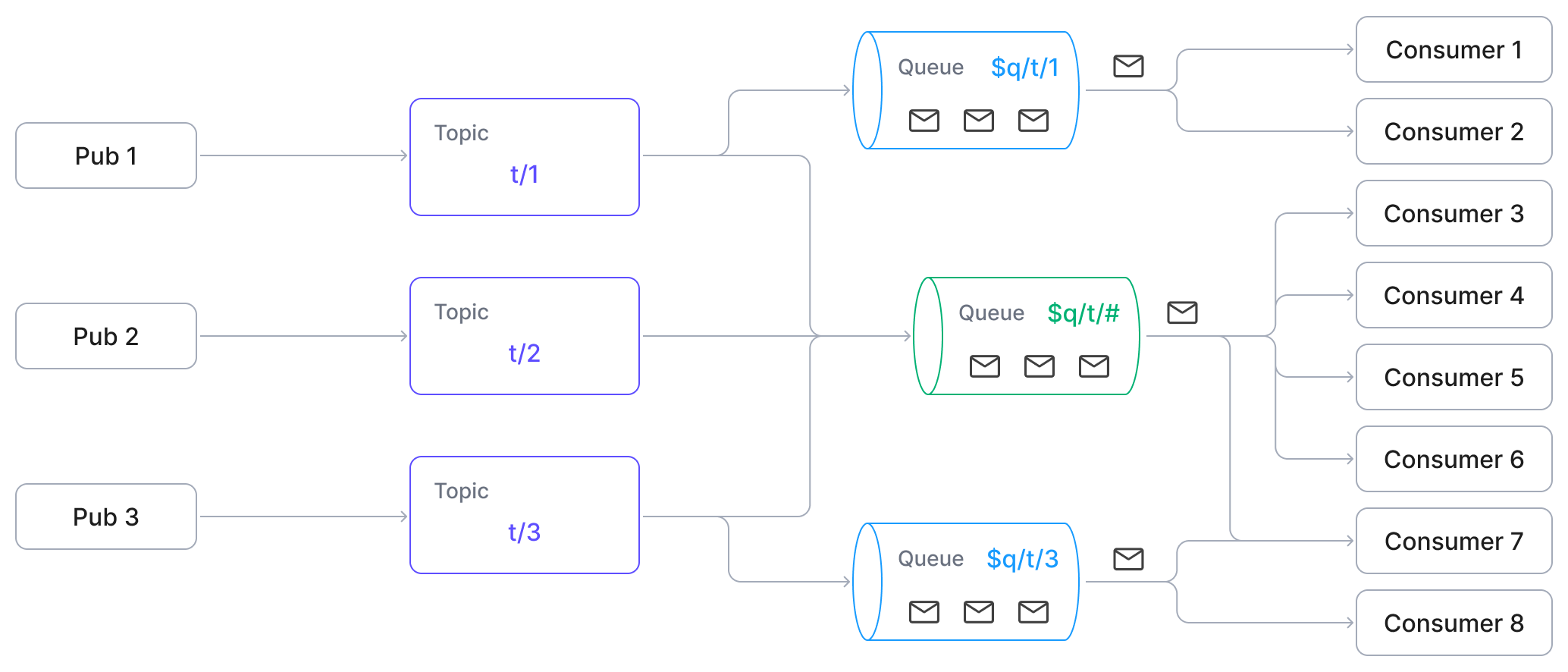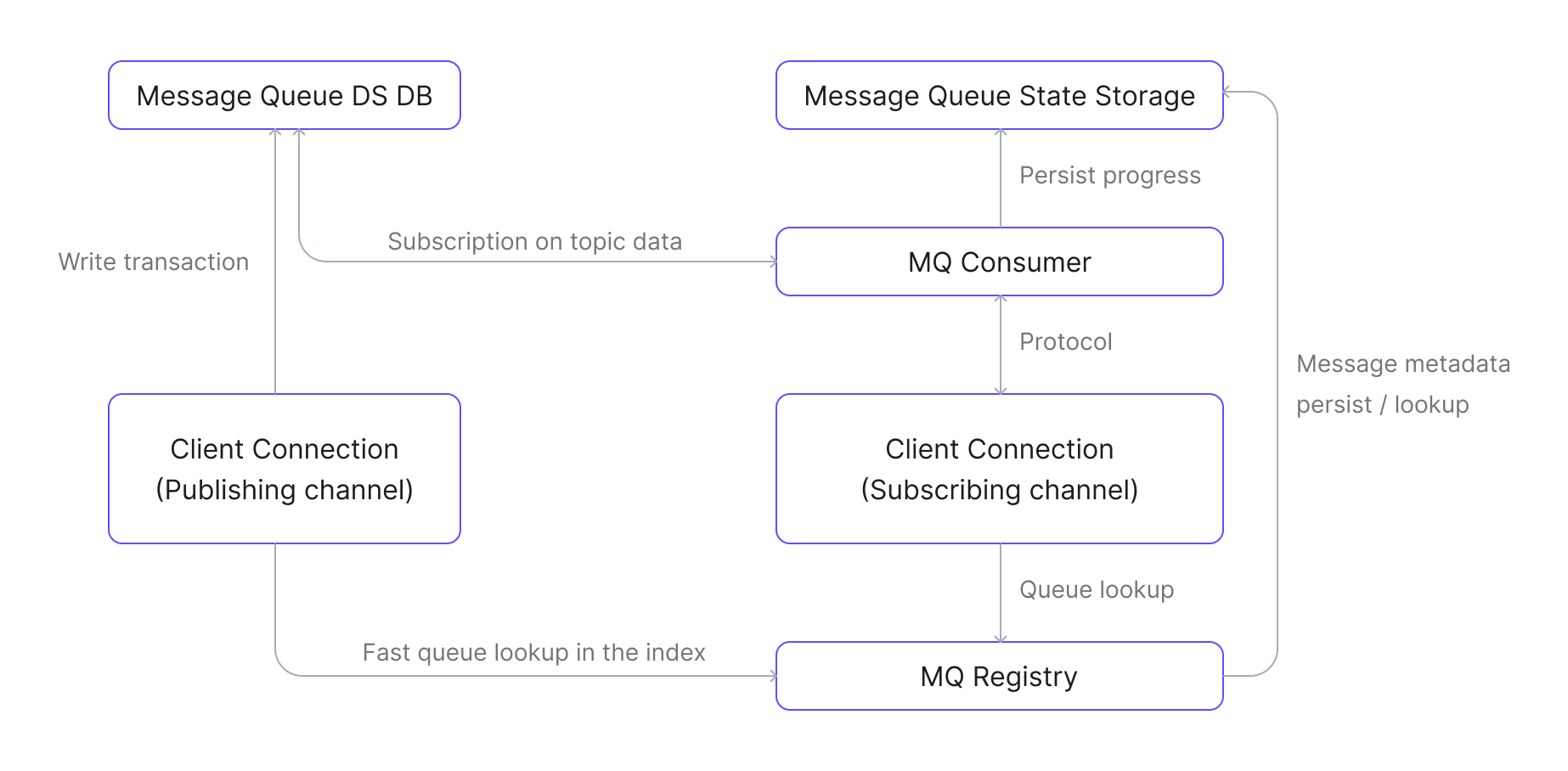Message Queue
The Message Queue feature introduced in EMQX 6.0 extends the MQTT subscribe/publish pattern with durable queue semantics, enabling reliable, asynchronous message delivery. It enhances native MQTT capabilities with features commonly found in enterprise-grade message queues, such as RabbitMQ, without requiring additional infrastructure.
This page provides a complete overview of the Message Queue feature in EMQX, covering its design motivation, key concepts, internal architecture, message flow, and real-world application scenarios.
What is a Message Queue?
A Message Queue in EMQX is a durable, server-side buffer that holds MQTT messages independently of subscriber availability. Each queue is associated with a specific topic filter, and automatically stores all messages that match the filter during its lifetime.
Unlike traditional MQTT behavior, Message Queues persist messages even when no clients are online. Clients can consume these messages by subscribing to the special $q/{topic} format.

Why Use Message Queue?
MQTT is a lightweight and widely adopted publish/subscribe protocol. However, its default behavior tightly couples message delivery to subscriber availability, which can be limiting for asynchronous or delayed-consumption scenarios.
Limitations of MQTT
While MQTT supports some queue-like features through shared subscriptions ($share/{group}/topic), it has limitations:
- Messages are not retained if no subscribers are online.
- No built-in support for Time to Live (TTL), queue size limits, or overflow control.
- No message deduplication, such as keeping only the latest value per key.
- No explicit lifecycle management for queues.
These limitations make it difficult to implement patterns like:
- Sending commands to devices before they come online.
- Submitting tasks to workers who are not always connected.
- Retaining only the latest state or configuration update.
Extend MQTT with Message Queue
Message Queue extends the MQTT protocol in EMQX. It allows messages to be persisted regardless of the subscribers' online status for further processing. It offers:
- Persistent message storage (even when clients are offline): While queues are not strictly ordered, they are designed for reliable and asynchronous delivery, bridging the gap between lightweight MQTT communication and more advanced enterprise messaging needs.
- Explicit queue declaration and property configuration: Each queue has a configurable lifecycle, with support for TTL, size limits, and dispatch strategies, allowing fine-grained control over how messages are retained and delivered.
- Optional Last-Value Semantics: Messages with the same key overwrite previous ones, ideal for retaining only the latest state or configuration update.
Message Queue Concepts
Queue Name
An MQTT topic or topic filter that identifies the queue. Messages published to matching topics are automatically enqueued.
Queue Declaration
The process of creating a durable queue and defining its behavior through configurable properties.
Queue Deletion
The removal of a queue along with all its stored messages.
Last-Value Semantics
An optional feature enabled by setting a Queue Key Expression during queue declaration. When enabled, EMQX will extract the
queue keyfrom each message as it enters the queue. A new message with the same key will overwrite any existing unconsumed message in the queue with that key. This behavior is ideal for stateful messaging or configuration updates, where only the latest value matters and older messages can be safely discarded.Topic Prefix
Queue subscriptions use the special
$q/{topic}prefix to distinguish them from regular MQTT subscriptions.Queue Properties
Customizable settings that control queue behavior, such as message retention time and dispatch strategy.
Quality of Service (QoS)
All messages in Message Queues are delivered with QoS 1 (at-least-once), regardless of the QoS level used when publishing or subscribing. This ensures reliable message delivery and unifies the queue's delivery behavior.
Message Persistence
Messages are retained even when no subscribers are connected. By default, queues apply last-value semantics. For regular queues (without a key expression), messages are stored in the order received.
How Message Queue Works
The Message Queue feature in EMQX is implemented as a loosely coupled extension and intercepts publish and subscribe operations using internal hooks. These hooks interact with a registry and storage layer to persist and deliver messages reliably.
Main Components
The following main components are involved:
- Message Queue Registry: Manages the lifecycle of all message queues. Responsible for creating, deleting, and looking up queues.
- Message Queue Message DB: Stores the actual messages published to queues and is built on EMQX’s Durable Storage.
- Message Queue State Storage: Persists consumption progress and queue metadata (e.g., TTL, properties).
- Message Queue Consumer: Retrieves messages from the queue and dispatches them to connected subscribers based on the dispatch strategy.
- Message Queue Subscription Registry: Tracks which channels (clients) are subscribed to which queues. Stores subscription state in each channel’s context.
- Message Queue Hooks: Hook into publish and subscribe events to intercept messages and route them to queues or consumers.
Message Queue Data Flow Diagram
The diagram below shows the data flow between major Message Queue components:

Publishing Workflow
- A client publishes a message to a regular topic, such as
some/topic. - An internal MQ hook is triggered to process the message.
- The hook checks the Message Queue Registry for any queues whose topic filter matches the published topic.
- If a matching queue is found, the message is written to the queue’s message database.
Subscribing and Consuming Workflow
- A client subscribes to a topic.
- An MQ hook is triggered to handle the subscription.
- If the topic is a message queue topic (
$q/some/topic), the hook initializes the subscription in the client session context and establishes a connection to the Message Queue Consumer. - If no consumer exists for the queue, a new Message Queue Consumer is started.
- The consumer restores message consumption progress and starts to fetch data from the message database.
- The consumer dispatches received messages to the subscriber client sessions based on the configured dispatch strategy.
- The subscriber client sessions deliver the messages to the clients via standard MQTT mechanisms.
Message Queue Core Features
The Message Queue feature in EMQX provides a set of core capabilities that enable reliable, decoupled, and configurable message delivery.
Enqueueing Messages Messages published to topics matching a declared queue are automatically enqueued.
If the queue is configured with a Queue Key Expression (for last-value semantics), the EMQX evaluates the expression against each message:
- If a key is derived, it replaces any unconsumed message with the same key.
- If a key fails to evaluate for a last-value queue, the message is discarded.
Dequeueing Messages Subscribed clients receive messages from the queue according to the configured dispatch strategy. All messages in Message Queues are delivered with QoS 1 to ensure reliable message delivery. Acknowledgments (for QoS 1) trigger message removal from the queue.
Dispatch Strategies You can define how messages are distributed across subscribers:
random: Distribute randomly.round_robin: Rotate among available subscribers.least_inflight: Prefer subscribers with fewer in-progress messages.
Queue Management Full queue lifecycle operations (create, update, delete, query) are available via REST APIs.
Use Cases
Message Queue enables reliable, asynchronous messaging patterns that are critical in many IoT and event-driven application scenarios, especially where devices or consumers may not always be online.
- Device Command Queuing: Cloud applications queue commands for IoT devices, ensuring commands will not be lost when devices are offline.
- Batch Processing: Break large datasets or workloads into smaller tasks and distribute them to worker clients for parallel or delayed processing.
- Sensor Data Processing: Temporarily queue high-frequency sensor data for batch processing, aggregation, or analysis at a later time.
- Latest Configuration Dispatch: Ensure devices always attempt to fetch and process the latest configuration command; older, unhandled commands (for the same config item/key) are superseded or marked obsolete in the queue.
Related Features Reference
Message Queue builds upon MQTT and complements other messaging features in EMQX:
- Shared Subscriptions: Distributes messages among multiple subscribers, but does not retain messages when no clients are online.
- Retained Messages: Stores the last known message for a topic, but only delivers one retained message per topic to new subscribers.
- MQTT Durable Sessions: Preserves session state (subscriptions and QoS 1/2 messages) for individual clients across reconnects.
- Rule Engine: Enables the filtering and processing of queued messages using SQL-like rules for further transformation or forwarding.
Next Steps
Now that you understand the Message Queue fundamentals, explore how to put them into practice:
- Create and Configure a Queue: Learn how to declare queues via Dashboard or REST API, define dispatch strategies, and set retention policies.
- Quick Start Tutorial: Follow a step-by-step guide using MQTTX to simulate real-world publisher and subscriber scenarios.